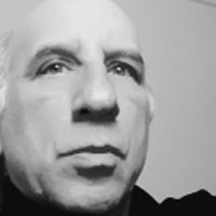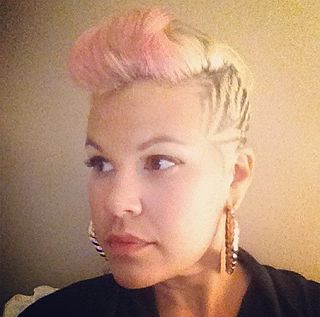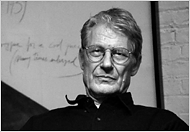Related Research Articles

Nam June Paik was a Korean American artist. He worked with a variety of media and is considered to be the founder of video art. He is credited with the first use (1974) of the term "electronic super highway" to describe the future of telecommunications.
Juan Downey was a Chilean artist who was a pioneer in the fields of video art and interactive art.
Gerome Kamrowski was an American artist and pioneer in the Surrealist and Abstract Expressionist Movements in the United States.
Richard Dean Tuttle is an American postminimalist artist known for his small, casual, subtle, intimate works. His art makes use of scale and line. His works span a range of media, from sculpture, painting, drawing, printmaking, and artist’s books to installation and furniture. He lives and works in New York City, Abiquiú, New Mexico, and Mount Desert, Maine.

Kenneth Feingold is a contemporary American artist based in New York City. He has been exhibiting his work in video, drawing, film, sculpture, photography, and installations since 1974. He has received a Guggenheim Fellowship (2004) and a Rockefeller Foundation Media Arts Fellowship (2003) and has taught at Princeton University and Cooper Union for the Advancement of Art and Science, among others. His works have been shown at the Museum of Modern Art, NY; Centre Georges Pompidou, Paris; Tate Liverpool, the Whitney Museum of American Art, New York, among others.
Peter Campus, often styled as peter campus, is an American artist and a pioneer of new media and video art, known for his interactive video installations, single-channel video works, and photography. His work is held in the collections of numerous public institutions, including The Museum of Modern Art, Whitney Museum of American Art, Solomon R. Guggenheim Museum, Hamburger Bahnhof - Museum für Gegenwart, Tate Modern, Museo Reina Sofía, Albright-Knox Art Gallery, Walker Art Center, and the Centre Georges Pompidou. The artist works on the south shore of Long Island where he resides with his wife, artist Kathleen Graves.

Mary Lucier is an American visual artist and pioneer in video art. Concentrating primarily on video and installation since 1973, she has produced numerous multiple- and single-channel pieces that have had a significant impact on the medium.
Bradley Walker Tomlin belonged to the generation of New York School Abstract Expressionist artists. He participated in the famous ‘’Ninth Street Show.’’ According to John I. H. Baur, Curator of the Whitney Museum of American Art, Tomlin’s "life and his work were marked by a persistent, restless striving toward perfection, in a truly classical sense of the word, towards that “inner logic” of form which would produce a total harmony, an unalterable rightness, a sense of miraculous completion...It was only during the last five years of his life that the goal was fully reached, and his art flowered with a sure strength and authority."
Michael Rees is an American artist practicing sculpture making, installation, animation, and interactive computing. He has exhibited his works widely, including at the Whitney Museum of American Art, New York, NY ; Bitforms gallery, Universal Concepts Unlimited, The Aldrich Museum of Contemporary Art, Ridgefield, CT, The MARTa Museum, Herford, Germany, and The Kemper Museum of Contemporary Art, Kansas City, MO. He has experimented with a broad practice that includes performance, interactive computer programs, digital modeling and fabrication, animation, and video. Rees' work with digital media has been written about and illustrated in books, articles, and catalogues for exhibitions. His talk at the Rothko Chapel, Houston, Texas is also published.
Paul Thek was an American painter and, later, sculptor and installation artist. Thek was active in both the United States and Europe during his life, staging a number of ambitious installations and sculptural works throughout his lifetime. Posthumously, he has been widely exhibited throughout the United States and Europe, and his work is held in numerous collections including the Hirshhorn Museum and Sculpture Garden in Washington, DC, the Centre Georges Pompidou, Paris, and Kolumba, the Art Museum of the Archdiocese of Cologne.
Peter Sarkisian is an American video and multimedia artist who lives and works in Santa Fe, New Mexico.
Herman Trunk, also known as Herman Trunk Jr., was an American painter active in the modernist movement of the 1920s and 1930s. He exhibited alongside some of the most famous artists of the day. At present his contributions to figurative abstract art are being recovered by scholars and critics. His work was part of the painting event in the art competition at the 1932 Summer Olympics.

Heather T. Hart is a visual artist who works in a variety of media including interactive and participatory Installation art, drawing, collage, and painting. She is a co-founder of the Black Lunch Table Project, which includes a Wikipedia initiative focused on addressing gender gap and diversity representation in the arts on Wikipedia.
Jordan Wolfson is an American artist living and working in Los Angeles. His enigmatic, and at times provocative, work investigates the darker side of the human condition. He explores such topics as violence, sexism, antisemitism, and racism in popular culture, using video and film, sculptural installation, and virtual reality.

Hans Dieter Breder was a German-American interdisciplinary artist. He lived and worked in Iowa.

Adam Frelin is an American artist working in sculpture., video, photography, and performance. He received a BFA from Indiana University of Pennsylvania, and an MFA University of California, San Diego. He has shown at venues such as the Getty Center, Aldrich Contemporary Art Museum, I-Park Foundation, the Columbus Museum, Samson Projects Evergreen House and Contemporary Art Museum St. Louis.
John G. Hanhardt is an American author, art historian, and curator of film and media arts. Hanhardt was the Consulting Senior Curator for Media Arts at the Smithsonian Museum of American Art, where he developed exhibitions, collections, and archives in film and the media arts. He is considered to be one of the leading scholars on video artist Nam June Paik.
Paul Henry Ramirez is an American contemporary artist known for his biomorphic abstractionist paintings. As his figural based paintings evolved to include geometrics, in 2010, Ramirez coined the term "biogeomorphic abstraction" to describe his own bold painting style, a fusion of biomorphic and geometric forms. He also gained notability for his site-specific installations as his paintings began to expand outside the confines of the canvas edges onto the walls of the gallery space. These site-specific installations gradually evolved to encompass the whole gallery space, creating a full environmental experience. Donald Kuspit, scholar and art critic, describes Ramirez as “an important new kind of abstract painter. .. an abstractionist playing with color and form to exciting imaginative effect.”

Rob Wynne is an American visual artist best known for his use of glass to produce abstract and text wall installations. He lives and works in New York City.

Dieter Froese (1937-2006) was a pioneering video installation artist who also worked in film, sculpture, and photography.
References
- Interfunktionen #8, published by Friedrich Wolfram Heubach, Cologne, Germany, January 1972, pages 84–89
- Barbara Radice, "Story Art", Data Arte, July–August 1975, Milano, Italy, pp. 84, 107-109 ill.
- Joseph Jacobs, "When Video Was Young", Art in America, May 2007, pg. 119-121, ill. 121
- Pierre Tillet, Domicile Prive/Public, Musee d'Art Moderne de Saint-Etienne Metropole, France, pg. 216-219, 2005
- Gerrit Henry, "Roger Welch", Art in America, December 2001, review of Neuberger Museum of Art exhibition, page 128 ill.
- Robert C. Morgan, "Intimate Art", Tema Celeste, May 2000, pg. 40-41ill.
- Lucy Lippard, The Lure of the Local, published by the New Press, New York, 1997, pg. 80-81 ill.
- Michael Archer, Installation Art, Edited by Nicolas de Oliveira, Michael Petry, Nicola Oxley, Thames and Hudson Ltd., London, 1994 p. 110, ill.
- William Zimmer, "A Genre Comes Into Its Own", The New York Times, Sunday, August 2, 1992 (NJ), pg. 11.
- Jeffrey Deitch, "Subconscious Sculpture", Roger Welch: Sculpture of Memory, (exhibit catalogue), Museo de Arte Moderno, Mexico City 1980, p. 9-12
- I. Michael Danoff, The Art of Roger Welch, Roger Welch (exhibit catalogue), Milwaukee Art Center, Milwaukee, Wisconsin, 1974, p.p. 2-7